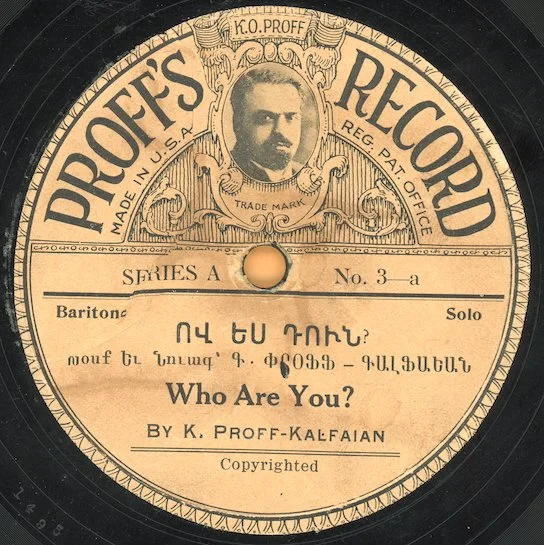Krikor Proff-Kalfaian: A Composer’s Journey
Written by Harout Arakelian
Krikor Proff-Kalfaian
Born: December 21, 1873, Bursa
Died: 1949, Fresno, California
Active years (recording): 1927
Label Association: Proff’s Records
“Yes, the power of song is great, very great! It is by grace of that power that the Church, the School, and the Theatre come and sit and place themselves in our homes, in our hearts, in the depths of our souls.” -Krikor Proff-Kalfaian, 1927
In the late 19th century and the early decades of the 20th century, Armenian musicians began making efforts to introduce Europeans to the wonders of Armenian music. Important figures in this effort include artists we have covered in the past, such as Gomidas Vartabed, Grigor Suni, and Armenag Shah-Mouradian. Among them, Krikor Proff-Kalfaian was an instrumental figure, a trendsetter who opened doors for fellow Armenian musicians. Included along with this article are two songs which make up one of the now scarcely available records self-produced by Proff-Kalfaian on his own self-titled label in 1925.
Krikor Proff-Kalfaian was born in Bursa on December 21, 1873. He began his music studies in Bursa, later furthering his studies in Constantinople and ultimately in France. In France, Proff-Kalfaian studied with the composer and teacher Vincent D’Indy. Through his work and relationship to D’lndy, Proff-Kalfaian became recognized for his mastery of music and was invited to be a member of the Music Composers Society of Paris in 1904.
In these early years, much of Proff-Kalfian’s output is centered around the publication of sheet music, running his own publication, Groung. Published in Paris, Groung was an annual art revue which ran for just two years (from 1904-1905) and focused on the publication of his own compositions as well as one composition by the little-known composer Karnig Parthamian. It was in this publication that Proff-Kalfian first printed his sheet music for his rendition of the song Groung.
The Balkan Wars convinced him to leave Europe for America, arriving in New York in 1913. Almost immediately, he is advertised in the Sunday New York Times with a performance at Aeolian Hall, where he presents for the “first time in America [a] composer’s concert of Armenian Music religious and popular by K. Proff-Kalfaian.” That same year, he settled in Worcester, Massachusetts, where he established a new choir for the local Armenian church. In 1918, he was invited to Fresno to become the choirmaster of the Holy Trinity Armenian Church.
When it came to the development of Proff-Kalfaian’s published compositions, two luminary singers of the period, Armenag Shah-Mouradian and Torcom Bezazian, were instrumental. Armenag Shah-Mouradian, who was Gomidas’ friend and collaborator, became a very popular performer and recording artist in both Europe and the United States. Similarly, Torcom Bezazian was a popular opera and vaudeville star whose recordings for Columbia and Victor records sold quite well. Like Proff-Kalfaian, both Torcom Bezazian and Armenag Shah-Mouradian studied with Vincent D’Indy, and both vocalists extensively performed Proff-Kalfaian’s compositions: Shah-Mouradian in his repertoire on the stage and Torcom Bezazian on several of his records. Included here is Torcom Bezazian’s recording of Proff-Kalfaian’s arrangement Nor-Oror, recorded in New York on February 5, 1915, for Columbia Records. For more information and music by Torcom Bezazian, see our Sound Archive feature on his work.
The recordings by Bezazian and others were popular, popular enough for Proff-Kalfaian to publish a song book before leaving Massachusetts for California. 1920 is a big year for Proff-Kalfaian: the popularity of his compositions on record and in the concert halls means he finally takes out copyrights for his compositions. In that year, he had seven songs credited to him, and dozens more thereafter. Among these copyrights is the composition titled “Who Are You/Ov Ess Toun.” Though he took out the copyright in 1920, the song wasn’t released on record until 1927. Between 1920 and 1927 Proff-Kalfaian was active leading his choir and continued to compose; in this period he even pens a patriotic song titled “O’ America,” with lyrics by the suffragist Alice Stone Blackwell. By 1927
Proff-Kalfaian also expanded his publishing efforts to recording, producing several discs performing his compositions. In December of 1925, he took out a full page article in the Asbarez newspaper alerting the readers that he’s going into production. When ready in late 1927, he published another announcement advertising his new records as “The best Christmas present;” he didn't disappoint and released his recordings just in time for Christmas.
Though his career continued into the 1930s, sadly, in 1949, Proff-Kalfaian fell ill and passed away in June of that year. But the contribution he and his cohort made on the awareness and popularity of Armenian music within the Western classical music scene of the early 20th century is largely because of their tireless efforts to promote, publish, and perform their songs in print, on stage, and on record. Now, 98 years later, we invite you to the voice of Krikor Proff-Kalfian in song, as he asks such a simple question, “Ov Ess Toun/Who Are You.”
“And if not everyone can satisfy their musical longings with a piano, or with a violin, or with any instrument, today everyone can enjoy the benefits of Song and Music by the grace of Records. Blessed be their inventors, who undoubtedly belong to the holiest class of trailblazers of education of the human soul.
And in particular, Armenian Song records have a high and noble role to play – especially for the Armenians of America and of the entire Diaspora.” -Krikor Proff-Kalfaian, 1927
Title page to musical score, “L'esparance: chant patriotique Armenien / musique de K. Proff-Kalfaian.” Published 1918. (Image Source: From the collection of Nazik Messerlian, digitized in collaboration with the Armenian Studies Program, California State University, Fresno.)
A special thanks to the SJS Charitable Trust for their generous support of our work to digitize and share our collection of 78 rpm records.


